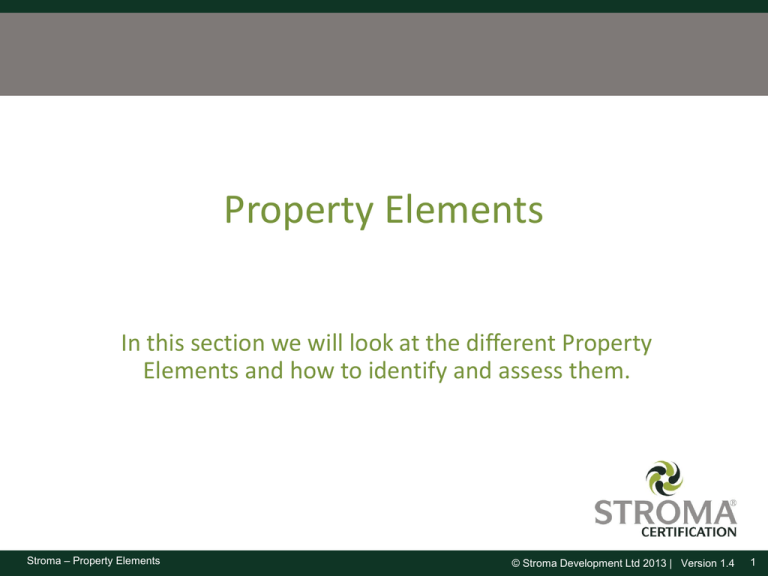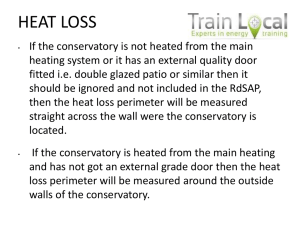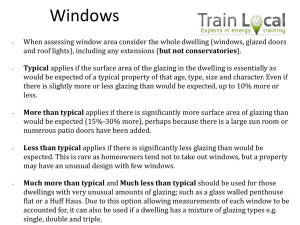5. Property elements
advertisement

Property Elements In this section we will look at the different Property Elements and how to identify and assess them. Stroma – Property Elements © Stroma Development Ltd 2013 | Version 1.4 1 Property Elements • This section of the training will cover a variety of property elements – – – – – – – – – – Flats/Maisonette Floor and roof heat loss types Extensions Room in Room Basements Conservatories Porches Alternative walls Windows Lighting Stroma – Property Elements © Stroma Development Ltd 2013 | Version 1.4 Flat or Maisonette • Technically there is no difference between a flat and a maisonette in RdSAP, the only difference is the description on the 1st page of the EPC. Stroma Certification uses the following definitions for these dwelling types as a guide : • A flat is generally defined as a self contained residential unit within a larger structure, containing several self contained unit or units all sharing a common entrance. They are usually single storey dwellings. • A maisonette is a dwelling which occupies 2 or more floors within a block. It can also be described as dwelling has its own access directly from the outside (i.e no communal corridor) but is not a stand-alone building. Stroma – Property Elements © Stroma Development Ltd 2013 | Version 1.4 Corridors Stroma – Property Elements © Stroma Development Ltd 2013 | Version 1.4 Corridors • In RdSAP there are three corridor selections - None, Heated or Unheated • You will only be asked for the corridor type for flats and maisonette’s • If the corridor is unheated, measure the length of corridor adjacent to the flat, including the flat door • The length of the unheated corridor must be included in the total heat loss (HLP) measurement for the flat Stroma – Property Elements © Stroma Development Ltd 2013 | Version 1.4 5 Floor Level mid floor flat • It is very important to correctly identify whether the flat is: – – – – Basement Ground floor Mid floor Top floor • Even if the lowest floor level of the dwelling extends over more than one floor enter it as the lowest floor e.g. ground and first floor flat would be entered as ground. Stroma – Property Elements © Stroma Development Ltd 2013 | Version 1.4 Definition of Enclosed Property When assessing a flat the detachment may not be obvious Flat A Flat B Heated Flat If the Access Corridor is unheated: – Flat A is an end terrace – Flat B is a mid terrace Access Corridor If the Access Corridor is heated: Heated Flat Stroma – Property Elements Heated Flat Heated Flat – Flat A is an enclosed end terrace – Flat B is an enclosed mid terrace © Stroma Development Ltd 2013 | Version 1.4 Floor heat loss type In RdSAP it is necessary to indicate what type of heat loss the lowest floor of a dwelling has. This applies to all dwelling types – houses, bungalows, flats, maisonettes • he options for floor type are – Ground floor – Above partially/intermittently heated space (Commercial Premises) – Above an unheated space (basement, Garage) – To external air – Same dwelling below (vertical extensions) – Another dwelling below (another flat below) Stroma – Property Elements © Stroma Development Ltd 2013 | Version 1.4 Floor heat loss type Ground floor Stroma – Property Elements • This will apply to most houses, bungalows and ground floor flats • It simply means the lowest floor of the dwelling is on the ground • If a dwelling has a basement which is not included in the assessment then the lowest floor will not be on the ground. © Stroma Development Ltd 2013 | Version 1.4 9 Floor heat loss type Above partially/intermittently heated space • • This option should be used when the lowest floor or the dwelling or part of a dwelling (main/extension) is located over a commercial premises It is termed partially or intermittently heated because commercial premises are assumed to have a different heating pattern to residential buildings Stroma – Property Elements © Stroma Development Ltd 2013 | Version 1.4 Floor heat loss type Above an unheated space • This option should be used when the lowest floor of the dwelling or part of the dwelling is over an enclosed space which is not heated, such as a garage or unheated basement Stroma – Property Elements © Stroma Development Ltd 2013 | Version 1.4 Floor heat loss type To external air • • This option is to be used when the lowest floor of a dwelling, or part of a dwelling is exposed to the outside Some houses and flats have a tunnel passing under the first floor through to the rear of the building Stroma – Property Elements © Stroma Development Ltd 2013 | Version 1.4 Floor heat loss type Same dwelling below • To be used when the lowest floor of part of a dwelling has been built over the existing dwelling, also known as a vertical extension. (These will be covered later ) Stroma – Property Elements © Stroma Development Ltd 2013 | Version 1.4 Floor heat loss type • Another dwelling below – To be used when the lowest floor of the dwelling or part of the dwelling is above another dwelling – Commonly used for mid and top floor flats, but can also be used for flying freeholds, i.e. when part of a property is located over another property Stroma – Property Elements © Stroma Development Ltd 2013 | Version 1.4 Roof heat loss type • As with floors it is necessary to indicate what type of heat loss the roof of a dwelling has. • This applies to all dwelling types – houses, bungalows, flats and maisonettes • The options for roof type are – – – – – – Pitched (slates or tiles), access to loft Pitched (slates or tiles), no access to loft Pitched (thatch) Flat Same dwelling above Another dwelling above Stroma – Property Elements © Stroma Development Ltd 2013 | Version 1.4 Roof heat loss type • When assessing the roof type you are concerned with the dwelling being surveyed, not always the whole building. E.g. when surveying flats. • If you were to survey the ground floor flat of this building, what would you think is the most appropriate statement about the roof type? Stroma – Property Elements © Stroma Development Ltd 2013 | Version 1.4 Roof heat loss type Another dwelling above – This option is usually used for ground and mid floor flats. By selecting ‘another dwelling above’ the software knows there is another dwelling above the flat surveyed. – This option can also be used for under-dwellings and similar building arrangements where part of another dwelling is built over the property surveyed. Stroma – Property Elements © Stroma Development Ltd 2013 | Version 1.4 Roof heat loss type Same dwelling above – This option can be used when part of a dwelling has had an extension built above it, known as a vertical extension. (This will be explained in more detail later in this section.) – The roof type simply indicates to the software that there is no heat loss Stroma – Property Elements © Stroma Development Ltd 2013 | Version 1.4 Extensions • Many properties have extensions added to the original building. These can be identified separately in an EPC. But an extension doesn’t have to be a later addition to a property to be classified as such in RdSAP. For the purposes of RdSAP an extension is part of a property which has different thermal qualities to the rest of the house • This can be due to: – – – – Age Wall construction/insulation type Roof construction/insulation type Floor heat loss type Stroma – Property Elements © Stroma Development Ltd 2013 | Version 1.4 Extensions • RdSAP allows for 4 extensions, which is generally more than enough for the majority of properties. • If a property has one or more extensions separate information must be recorded for each of them. – For each part of the dwelling the following data should be collected: • Dimensions • Wall construction and insulation • Roof construction, insulation and heat loss types • Floor construction, insulation and heat loss type • Build date Stroma – Property Elements © Stroma Development Ltd 2013 | Version 1.4 Examples of Extensions Different roof types • • Stroma – Property Elements Main property – pitched roof Extension – flat roof © Stroma Development Ltd 2013 | Version 1.4 Extension Examples Wall construction • • Stroma – Property Elements Main property – solid brick Extension – cavity © Stroma Development Ltd 2013 | Version 1.4 Extension Examples Roof insulation • • Stroma – Property Elements Main property – insulation at joists, 250mm Extension – no access to loft, unknown insulation © Stroma Development Ltd 2013 | Version 1.4 Extension Examples Build date • • Stroma – Property Elements Main property – 1900-29 Extension – 1991-95 © Stroma Development Ltd 2013 | Version 1.4 Extension Over A Garage • • • • If a property has an extension over an unheated garage or similar unheated space, it should be entered as an extension on the lowest floor This is because the garage is not included in the survey, and it is not possible to leave the lowest floor blank in the software. The floor heat loss type should be entered as ‘over unheated space’ If the garage is heated by the main heating system, it should be included in the survey Stroma – Property Elements © Stroma Development Ltd 2013 | Version 1.4 Vertical Extensions Vertical extension Main property A vertical extension is an additional storey to a property which can not be accounted for as a room in the roof. Identify the vertical extension as an extension in the software, taking separate information for the whole extension area. • Specify the upper floor heat loss type as ‘same dwelling below’ • Specify the lower floor roof type as ‘same dwelling above’ Stroma – Property Elements © Stroma Development Ltd 2013 | Version 1.4 Vertical Extensions Main property roof type: pitched roof Main property floor type: ground floor Main Property Extension 2 Extension 1 Extension 2 Floor type: Same dwelling below Extension 2 Roof type: Pitched roof Extension 1 floor type: ground floor Extension 1 roof type: same dwelling above If the vertical extension does not cover the whole dwelling the part of the dwelling below the vertical extension must also be identified as an extension in order to specify the roof type as ‘the same dwelling above’. Stroma – Property Elements © Stroma Development Ltd 2013 | Version 1.4 Multiple Extensions Extension 2 Extension 1 Main Property Extension 3 Extension 4 Extension 5 • Occasionally you may come across a house which has more than 4 extensions; in this situation you must ‘blend’ the extensions. • Merge the areas with the most similar age, construction and insulation, and make use of the alternative wall facility where appropriate. Stroma – Property Elements © Stroma Development Ltd 2013 | Version 1.4 Mezzanine floors • A mezzanine floor is usually an intermediate floor between two floors in a building. • A mezzanine floor does not extend across the whole dwelling • This means part of the property has more floors than the rest. • It also means that the ceiling height for part of the dwelling is significantly bigger than the mezzanine section. Stroma – Property Elements © Stroma Development Ltd 2013 | Version 1.4 Mezzanine floors • When assessing a dwelling which has a mezzanine floor split the dwelling vertically • The split should separate the property into a part with the mezzanine and a part without the mezzanine • Specify one part as the main property and the other part as an extension – In the picture the mezzanine makes part of the property 2 storey, the remainder of the property is 1 storey. – The 2 storey section is the main property, 2 storeys are measured and entered into the software, with separate ceiling heights for each storey – The single storey section is entered as an extension with just 1 storey entered in the software, and the full floor to ceiling height entered as the ceiling height. Stroma – Property Elements © Stroma Development Ltd 2013 | Version 1.4 Room in a Roof A room in a roof is defined by the following: 1. Access must be via a permanent fixed staircase that one is able to walk up and down facing forwards. (This does not include fixed loft ladders). 2. The height of the common wall must be less than 1.8m for at least 50% of the storey. Please note this does not include stud walls, gable ends or party walls. (The common wall is a vertical continuation of the external wall of the storey below.) If the common wall measures greater than 1.8m for more than 50% of the floor then it is classed as a normal storey. Measure floor area (internally); no need to measure room height or heat loss perimeter Stroma – Property Elements © Stroma Development Ltd 2013 | Version 1.4 Rooms in Roof • Would this be a room in the roof? • Height of wall at eaves (common wall) is less than 1.8m • This is classed as a room in roof Stroma – Property Elements © Stroma Development Ltd 2013 | Version 1.4 Not a Room in the Roof If the 50% or more of heat loss walls at the eaves (common wall) are 1.8 metres high or greater , the space is classed a normal floor and you will need to take the measurements of wall perimeter (heat loss walls), room height and the floor area. Stroma – Property Elements © Stroma Development Ltd 2013 | Version 1.4 Why have room in roof? When you say a property has a room in roof it means the software makes the following assumptions – The wall construction is timber frame (i.e. the roof construction, rather than cavity wall, solid brick etc – The ceiling height is assumed to be 2.2m high. It can be difficult to get an average ceiling height for rooms in roof due to the sloping ceiling – The heat loss perimeter is based on that of the storey below. During test surveys carried out prior to the release of RdSAP, assessors were asked to measure the heat loss perimeter of the room in roof, but assessors came back with such varied results for the test properties that it was decided that this figure should be assumed to avoid too greater variation in ratings. Effectively, when you specify a room in roof, you are saying that the majority of heat loss for the storey is through the roof rather than the wall construction specified in the software. Stroma – Property Elements © Stroma Development Ltd 2013 | Version 1.4 Partially insulated roof rooms Stroma – Property Elements © Stroma Development Ltd 2013 | Version 1.4 Partially Insulated Roof Rooms • Presently, RdSAP assigns a flat roof area, and the remainder as wall area, based on the floor area entered • This is a useful estimation in most cases, however this may not prove sufficiently accurate in certain scenarios • If it is judged the roof room vastly differs from the default values, the software allows areas and insulation to be recorded separately – – – – stud walls gable walls sloping parts flat ceiling parts • It will also be possible to indicate in the software whether the room in roof is connected to another part of the dwelling i.e. extension. Stroma – Property Elements © Stroma Development Ltd 2013 | Version 1.4 Partially insulated roof rooms • in some cases it is not possible to get the Roof Room insulation levels. This is when default values are used by the software. Stroma – Property Elements © Stroma Development Ltd 2013 | Version 1.4 Partially insulated roof rooms • If can only get access to certain parts of the insulation you can enter either; — All elements — Flat ceiling only — Walls and sloping parts Stroma – Property Elements © Stroma Development Ltd 2013 | Version 1.4 Partially insulated roof rooms • When you can get the details of ALL roof room insulation, the following data can be entered: – Actual area – Actual U-value 39 Stroma – Property Elements © Stroma Development Ltd 2013 | Version 1.4 Room in Roof Quiz 40 Stroma – Property Elements © Stroma Development Ltd 2013 | Version 1.4 Is it a room in roof? Here are a few slides of properties • Do you think the top floor is a room in roof or another storey? • You will be able to tell from the photo, and not have to measure the common wall height • Assume that there is access via a fixed staircase to the top floor of the property. Stroma – Property Elements © Stroma Development Ltd 2013 | Version 1.4 Is it a Room in Roof? Stroma – Property Elements © Stroma Development Ltd 2013 | Version 1.4 Is it a Room in Roof? Yes • The dorma windows are built into the roof • The common wall stops at the top of the first floor • The common wall is 0m for the roof room Stroma – Property Elements © Stroma Development Ltd 2013 | Version 1.4 Is it a Room in Roof? Stroma – Property Elements © Stroma Development Ltd 2013 | Version 1.4 Is it a Room in Roof? Yes • This is a dorma bungalow • The entire top floor is built within the roof structure, the cavity wall stops at the top of the ground floor • The dorma window is likely to be constructed using timber Stroma – Property Elements © Stroma Development Ltd 2013 | Version 1.4 Is it a Room in Roof? Stroma – Property Elements © Stroma Development Ltd 2013 | Version 1.4 Is it a Room in Roof? Yes • There are skylights in the roof of this property indicating there is an additional floor in this property • The common wall stops at the top of the 1st floor, so the whole top floor of the property is within the roof space Stroma – Property Elements © Stroma Development Ltd 2013 | Version 1.4 Is it a Room in Roof? Stroma – Property Elements © Stroma Development Ltd 2013 | Version 1.4 Is it a Room in Roof? • No • The common wall stops part way up the top floor but the window height is likely to be 2.1m • The common wall extends for more than 50% of the storey Stroma – Property Elements © Stroma Development Ltd 2013 | Version 1.4 Is it a Room in Roof? Stroma – Property Elements © Stroma Development Ltd 2013 | Version 1.4 Is it a Room in Roof? • Yes • The dorma window indicates there is a room in the roof space of this bungalow • The common wall stops at the top of the ground floor Stroma – Property Elements © Stroma Development Ltd 2013 | Version 1.4 Is it a Room in Roof? Stroma – Property Elements © Stroma Development Ltd 2013 | Version 1.4 Is it a Room in Roof? • Yes • The top floor has had a loft conversion and a large dorma window has been added • The dorma window has a different construction type to the floors below • The common wall type, solid stone, stops at the top of the 1st floor • Therefore the common wall is 0m on the top floor. Stroma – Property Elements © Stroma Development Ltd 2013 | Version 1.4 Is it a Room in Roof? Stroma – Property Elements © Stroma Development Ltd 2013 | Version 1.4 Is it a Room in Roof? • Yes • Another dorma bungalow • The top floor is built entirely within the roof structure and the common wall stops at the top of the ground floor Stroma – Property Elements © Stroma Development Ltd 2013 | Version 1.4 Is it a Room in Roof? Stroma – Property Elements © Stroma Development Ltd 2013 | Version 1.4 Is it a Room in Roof? • Yes • The common wall stops part way up the 1st floor • It is likely the common wall measures less than 1.8m Stroma – Property Elements © Stroma Development Ltd 2013 | Version 1.4 Measuring a room in roof • • • • • Measure the habitable space of the room in roof Do not include the area behind stud walls, often used as storage space Include the floor area of any dorma windows A room in roof should always be measured internally There is no need to measure the ceiling height or heat loss perimeter Stroma – Property Elements © Stroma Development Ltd 2013 | Version 1.4 Room In Roof Age • You are required to enter an age band for the Room in Roof. • The date selected will influence the level of insulation, particularly if there is no access to the room in roof insulation. (Further details on room in roof insulation will be covered later in the training course) • The age band for a Room in Roof may be different to that of the main property. • If the loft has been converted it may not be possible to ascertain evidence of the conversion date; in which case the original build date of the property should be used. Stroma – Property Elements © Stroma Development Ltd 2013 | Version 1.4 Flat in the roof If a single storey flat is located entirely in the roof, it cannot be entered as a Room in Roof: In this case: – Enter the wall construction as timber frame – The ceiling height should be entered as 2.2m – It will be necessary to record the floor area and heat loss perimeter for this type of flat. Stroma – Property Elements © Stroma Development Ltd 2013 | Version 1.4 Room in roof over a garage • If a room in roof is located over an unheated garage it should be entered as an extension • The dimensions should be entered as the lowest floor, it is not possible to leave the lowest floor data blank • Specify the following: – Floor heat loss type: exposed to unheated space – Wall construction: timber frame – Ceiling height: 2.2m Stroma – Property Elements © Stroma Development Ltd 2013 | Version 1.4 Basement • A basement has 50% or more it’s external walls adjacent to soil. • To be included in the survey a basement must – Be accessed via a fixed staircase which can be walked up and down facing forwards – Be heated by fixed heaters or – Be open to the rest of the dwelling • A basement does not have to contain habitable rooms to be included in the assessment • Walls adjacent to soil are included in the heat loss perimeter • Party walls should be considered as heat loss walls unless you can be sure that the neighbouring basement is heated. You should get evidence of this, such as a photo. Stroma – Property Elements © Stroma Development Ltd 2013 | Version 1.4 Number of Storeys loft space Room in roof First floor Ground floor Unheated basement/Cellar 2 Storey House First floor Ground floor Heated basement/Cellar 3 Storey House + room in roof A cellar or basement does not have to be a habitable space to be included in the survey. Stroma – Property Elements © Stroma Development Ltd 2013 | Version 1.4 Basement Convention 2.05 Basements (whether to include in the assessment) states Include when accessed via a permanent fixed staircase such that one is able to walk downwards facing forwards and either:- - basement is heated via fixed heat emitters, or - basement is open to the rest of the dwelling. Does not necessarily contain habitable rooms. Stroma – Property Elements © Stroma Development Ltd 2013 | Version 1.4 64 Porches If a porch is heated it should always be included in the EPC • If a porch is external and not heated it can be ignored • If a porch is internal, not heated and thermally separated it can be ignored An internal porch lies within the line of the external wall of the property, an external porch would protrude from the external wall, as shown in the image Stroma – Property Elements © Stroma Development Ltd 2013 | Version 1.4 Porches Convention 2.09 states Porches If heated always include (separated or not). If external and not heated, disregard. If internal, not heated and thermally separated,disregard Stroma – Property Elements © Stroma Development Ltd 2013 | Version 1.4 66 Conservatories A conservatory must have at least 50% glazed walls and 75% glazed roof Can be classed as separated or non-separated • If a conservatory is separated just note whether there are any fixed heaters • If the conservatory is non-separated then more information is required Stroma – Property Elements © Stroma Development Ltd 2013 | Version 1.4 Non-Separated Conservatories A conservatory is “non-separate” if it is thermally linked to the house, i.e. open plan or internal quality door separation – Collect the dimensions for: • Floor area • Glazed perimeter – Determine whether the majority of glazed walls are double glazed. – How high is the conservatory? – This is measured in storeys (1 storey, 1.5 storeys, 2 storeys or 2.5 storeys. A conservatory with an unglazed roof is a sun room and should be treated as an extension Stroma – Property Elements © Stroma Development Ltd 2013 | Version 1.4 Non-Separated Conservatory • This conservatory is open to the rest house – there is no separating door • This conservatory needs to be included in the survey Stroma – Property Elements © Stroma Development Ltd 2013 | Version 1.4 Separated Conservatory • This conservatory has an external quality door separating it from the rest of the dwelling • An external quality door is one which would be suitable as a front or back door Stroma – Property Elements © Stroma Development Ltd 2013 | Version 1.4 Would this be a conservatory Stroma – Property Elements © Stroma Development Ltd 2013 | Version 1.4 What about this one? • This is a sun room, it does not have at least 75% glazed roof so it cannot be entered as a conservatory in RdSAP • It should be included in the EPC as an extension unless all the construction, insulation and age details are the same as the main house • More than typical glazing should also by selected. Stroma – Property Elements © Stroma Development Ltd 2013 | Version 1.4 Alternative Wall An Alternative Wall is thermally different to main wall type and cannot be accounted for as an extension Stroma – Property Elements © Stroma Development Ltd 2013 | Version 1.4 Alternative Walls • An alternative wall can be applied to all parts of a dwelling. This includes the main property and all four extensions • Wall area is required (excluding any apertures) • If property is identified as a flat or maisonette, there is now an option for a ‘sheltered’ alternative wall. • A sheltered alternative wall is situated between the dwelling and an unheated corridor, or stairwell. This option can only used for the main building part. Stroma – Property Elements © Stroma Development Ltd 2013 | Version 1.4 Alternative walls • The convention for alternative walls is quite long, here are the key features – Walls of the same construction but different thickness within a building part are not considered alternative walls unless they are stone walls – For stone walls assess thickness at each external elevation and at each storey and use alternative wall if the thickness varies by more than 100mm – In the case of the wall separating the dwelling from an unheated corridor or stairwell, where this wall is of a different construction or insulation to the external walls (e.g. not insulated but external walls are), make it an alternative wall and mark it as sheltered Stroma – Property Elements © Stroma Development Ltd 2013 | Version 1.4 Windows • There are three features of the windows in a dwelling which must be recorded: – Window area – Percentage multiple glazed – Type of glazing Stroma – Property Elements © Stroma Development Ltd 2013 | Version 1.4 Window Convention • Typical applies if the surface area of the glazing in the dwelling is essentially as would be expected of a typical property of that age, type, size and character. Even if there is slightly more or less glazing than would be expected, up to 10% more or less. • More than typical applies if there is significantly more surface area of glazing than would be expected (15%-25% more), perhaps because there is a large sun room or numerous patio doors have been added. • Less than typical applies if there is significantly less glazing than would be expected. This is rare as homeowners tend not to take out windows, but a property may have an unusual design with few windows. • Much more than typical and Much less than typical should be used for those dwellings with very unusual amounts of glazing; such as a glass walled penthouse flat or a Huf Haus. Due to this option allowing measurements of each window to be accounted for, it should also be used if a dwelling has a mixture of glazing types e.g. single, double, secondary and triple. Stroma – Property Elements © Stroma Development Ltd 2013 | Version 1.4 77 Percentage Multiple Glazed • This is a calculation of the proportion of total window area which is double or triple glazed. • Please note that this calculation is based on total window area and not the number of windows. • When entering the multiple glazed percentages into the software, if the figure is less than 100% the remaining percentage is assumed to be single glazing. • 0% multiple glazing will indicate the property is fully single glazed Stroma – Property Elements © Stroma Development Ltd 2013 | Version 1.4 Glazing Type • Multiple glazing available for selection are as follows: – – – – – Double glazed pre 2002* Double glazed post 2002* Double glazed unknown Secondary glazing Triple glazing • Only one glazing type can be selected from this list. If more than one type is present at a property the most prevalent type should be selected. For example, a property had double glazing installed in 1998 and in 2004 two small units were replaced. Because the majority of the windows are still pre 2002, this should be selected in the software. *(2002 is the date for England and Wales, 2006 for Northern Ireland, 2003 for Scotland) Stroma – Property Elements © Stroma Development Ltd 2013 | Version 1.4 Identifying Glazing Type Double glazing can be entered as units installed before 2002 or after 2002. The 2002 building regulations introduced a minimum standard for the installation of double glazed units. This is indicated in a number of ways. – Some post 2002 windows have an air gap of +12mm, although more modern units injected with gas may have a narrower gap – Date stamp of 2002 or later on the metal strip inside the glazing unit or window frame Stroma – Property Elements © Stroma Development Ltd 2013 | Version 1.4 Identifying Glazing Type – Presence of gas fill – indicated by drill holes in the air gap – Presence of low-e coating – identifiable with a low-e detector – A FENSA certificate held by the owner/occupier. The FENSA website also holds details of properties with certified windows www.fensa.co.uk Earlier double glazing has a more narrow air gap, less than 12mm. If it is not possible to identify the date of installation, then the glazing should be entered as pre-2002. Stroma – Property Elements © Stroma Development Ltd 2013 | Version 1.4 Secondary Glazing Secondary glazing should only be accounted for in a survey if units are installed correctly. Temporary additional glazing, such as cling film, should not be included in the survey. Stroma – Property Elements © Stroma Development Ltd 2013 | Version 1.4 Triple Glazing Triple glazing can be identified by 3 panes of glass with 2 separate air gaps within the unit. The glazed unit will appear wide in comparison to a standard double glazed unit. Stroma – Property Elements © Stroma Development Ltd 2013 | Version 1.4 Window U-value and g-value • Where documentary evidence is available it is now possible to record the U-value and g-value for windows • U-value – The basic measure unit for establishing the heat loss of a construction segment – The unit is W/m2K – For the whole window, not just the glazing • g-value – The measure of solar heat gain – Stated as a percentage • The best setup is high thermal insulation, which means a low U value combined with a G value that is not too high Stroma – Property Elements © Stroma Development Ltd 2013 | Version 1.4 Window U-value and g-value • A U-Value or G-Value cannot be entered as a stand alone figure; both must be known and entered in the software and used in the calculation. If not known, existing defaults are used for the calculation • These can be obtained from either: – The manufacturer – British Fenestration Rating Council (BFRC) Stroma – Property Elements © Stroma Development Ltd 2013 | Version 1.4 Window U-value and g-value • • The BFRC Scheme is the UK’s national system for rating the energy efficiency of windows and is recognized within the Building Regulations as a method to show compliance for replacement windows installation Each window rated by the BFRC has a unique label This label will display the following information: 1. The rating level – A, B, C, etc… 2. The energy rating eg. -13kWh/(m²·K) in this example the product will lose 13 kilowatt hours per square metre per year. 3. The window U value eg. 1.6W/(m²·K) 4. The solar heat gain (g-value) eg. g=0.45 5. The effective heat loss due to air penetration (L factor) eg. 0.00 W/(m²·K) Stroma – Property Elements © Stroma Development Ltd 2013 | Version 1.4 Window U-value and g-value RdSAP convention 3.10 states: U-values and g-values can be overwritten only if documentary evidence is provided, which can be either a Window Energy Rating certificate (as defined by the BFRC) or manufacturer’s data. The U-value is for whole window, not centre pane. Stroma – Property Elements © Stroma Development Ltd 2013 | Version 1.4 Window orientation • Where the extended window data is used (when ‘much more than typical’ or ‘much less than typical’ is selected) you will now be required to record the orientation of each window • There will also be the option to include the U-value and g-values (if known and documentary evidence is available) Stroma – Property Elements © Stroma Development Ltd 2013 | Version 1.4 What is Draught Proofing? • Draught proofing is a cheap and efficient method of saving both energy and money. • Draughts are similar to ventilation in that they supply the home with fresh air. However, draughts are uncontrolled and can let in too much cold air as well as allowing heat to escape. • Draught proofing blocks up any unwanted gaps that let cold air in • Types of draught proofing can include: – Self adhesive sealant strips – Brushes – Spray foams (sprayed into gaps around windows) Stroma – Property Elements © Stroma Development Ltd 2013 | Version 1.4 Draught proofing • Previously RdSAP assumed that: – All double and triple glazing were draught proofed – All single glazed windows and doors were not draught proofed • RdSAP 9.91 does not make assumptions about draught proofing, the DEA will assess the percentage of draught proofed doors and windows • This will allow for more accurate recommendations for draught proofing Stroma – Property Elements © Stroma Development Ltd 2013 | Version 1.4 Types of Draught proofing • Weather strips • Brushes • Self adhesive sealant strips Stroma – Property Elements © Stroma Development Ltd 2013 | Version 1.4 Draught proofing RdSAP convention 3.11 states: All external doors and at least 2 windows per building should be examined If a window is locked or inaccessible then endeavour to check another one If the state of the draught proofing cannot be determined then take triple, double or secondary glazing as being draught proofed, and single glazed windows and doors as no draught stripped Include glazing in a non-separated conservatory The percentage of draught proofed is [(number of draught proofed windows and doors) divided by (total number of windows and doors)] x 100 Stroma – Property Elements © Stroma Development Ltd 2013 | Version 1.4 External Doors Stroma – Property Elements © Stroma Development Ltd 2013 | Version 1.4 External Doors • Until now RdSAP assumed the number of doors based on the built form. • It has also assumed the U-value of doors, but this does not account for high performance insulated doors • RdSAP 9.91 now requires DEAs to: – Count the number of external doors, including doors to unheated corridors or stairwells – Count the number of insulated external doors • It will be difficult to prove whether a door is insulated by a visual inspection alone. Documentary evidence must be provided For flats, if there is an unheated corridor the door is assumed to be for the corridor only, i.e. not external and not included. If a flat has more than one door, the remaining door(s) are external and included. Stroma – Property Elements © Stroma Development Ltd 2013 | Version 1.4 External Doors • It is also possible to enter the U-value for insulated external doors (if known and documentary evidence is available) • If the U-values of more than one door are known then calculate and record the average U-value Stroma – Property Elements © Stroma Development Ltd 2013 | Version 1.4 External Door convention RdSAP convention 3.09 states: An external door is a door that forms part of the heat loss perimeter of the dwelling A door to a heated access corridor is not included in the door count A door is counted as insulated only if documentary evidence is provided, which must include U-value or manufacturer reference enabling the assessor to ascertain the U-value from the manufacturer. If there is more than one insulated door and they have different U-values, enter the average U-value Stroma – Property Elements © Stroma Development Ltd 2013 | Version 1.4 Lighting • The low energy light count should only include fixed outlets • Lights that can be removed, such as lamps, should not be included • lights counted as Low energy are: – Compact fluorescent – Fluorescent tube – LED spot lights Stroma – Property Elements © Stroma Development Ltd 2013 | Version 1.4 Examples of Low Energy Lights Stroma – Property Elements © Stroma Development Ltd 2013 | Version 1.4 Lighting Lights in the following locations are not included in the light count: – – – – – – Cupboard Loft spaces Separated conservatories Porches not included in the survey Unheated garages Outside lights Stroma – Property Elements © Stroma Development Ltd 2013 | Version 1.4 What if there are downlighters? • Where there are 4 or or more downlighters/ceiling lights, divide the bulb count by 2 • Fixed under cupboard kitchen strip lights should also be included in the count Stroma – Property Elements © Stroma Development Ltd 2013 | Version 1.4 Photovoltaic-PV Stroma – Property Elements © Stroma Development Ltd 2013 | Version 1.4 101 Photovoltaic-PV There are two methods to assess PV systems • Roof percentage • System Details (which needs further information) – – – – Peak Power Pitch Orientation Overshading The peak power can be obtained through the MCS certificate. Pitch, Orientation and Overshading can be assessed on site. – 3 systems can be entered into the software per property Stroma – Property Elements © Stroma Development Ltd 2013 | Version 1.4 102 Wind Turbines • • • • The software will make the provision for only one type of turbine to be entered If however, a property has two turbines that differ in both hub and rotor height they must be combined and entered as one This is done using a calculation spread sheet which takes data of multiple turbine types and converts it into one figure The spread sheet will be made available on the Stroma member’s area RdSAP convention 9.07 states: Documentary evidence is required to overwrite default values Stroma – Property Elements © Stroma Development Ltd 2013 | Version 1.4 Wind Turbines • • • • This is another ‘yes/no’ option in the software If yes, the assumption is a 2m rotor with a 2m hub height This option will still be available but can be overwritten with valid documentary evidence The data to be collected can be seen on the table on the right Stroma – Property Elements © Stroma Development Ltd 2013 | Version 1.4 Any Questions? Stroma – Property Elements © Stroma Development Ltd 2013 | Version 1.4








